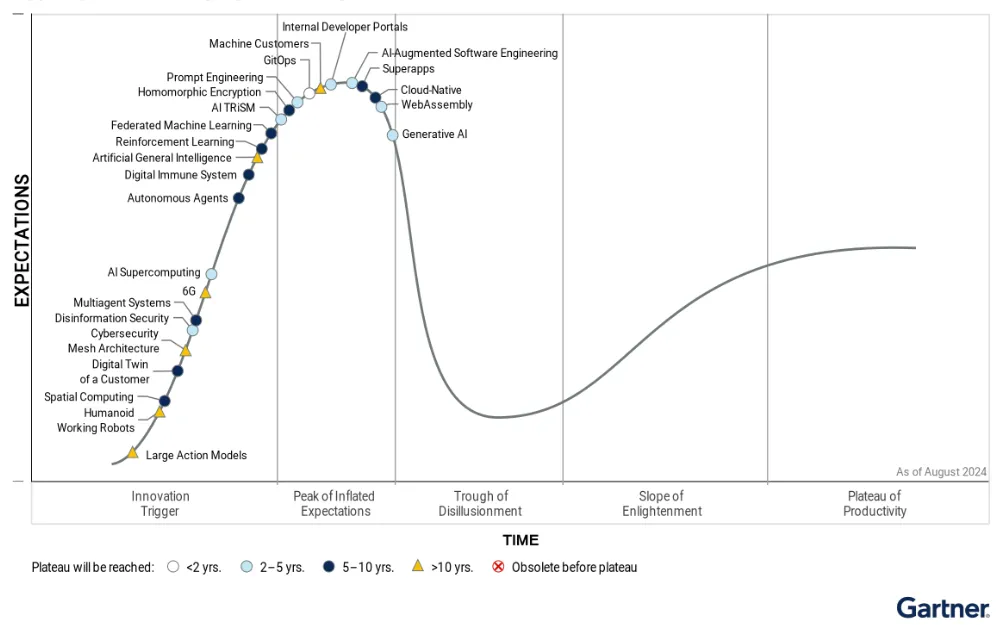Nearly two years since ChatGPT sparked a global generative AI fever, CIOs have turned talk into action, shifting priorities, setting up experiments and mitigating roadblocks along the way.
But as enthusiasm for generative AI shows signs of cooling, tech leaders will likely need to recalibrate their strategy.
Generative AI is approaching a moment of reckoning, according to Arun Chandrasekaran, distinguished VP analyst at Gartner. In Gartner’s annual Hype Cycle for Emerging Technologies report, the research and advisory company placed generative AI past the peak of inflated expectations, and down the path towards what it calls the trough of disillusionment.
The stage is characterized by dwindling excitement around the new technology as the rubber meets the road for early adopters.

Chandrasekaran said the disillusionment — or unhappiness with the technology — likely stems from three areas:
- Current models are versatile but mainly general purpose, and enterprises have struggled to steer them into enterprise use cases.
- Organizations have underestimated the challenge of setting up governance and data infrastructure for these capabilities.
- The initial wave of generative AI solutions, while valuable, may not be delivering the high promise vendors claimed.
The key for technology leaders is to not let the potential doom and gloom halt momentum entirely. CIOs can weather the storm by setting and reinforcing realistic expectations around generative AI and the ROI tied to specific projects.
“It would be a loss if the short-term disillusionment results in enterprises completely pulling away from AI,” Chandrasekaran said.
Creating methodical, rigorous testing for use cases will help narrow focus and avoid fruitless endeavors, which can certainly contribute to disillusionment. Not every idea brought to CIOs is a winner, and some use cases don’t even need AI.
This mindset shift takes the focus away from the technology itself, and instead, prioritizes what’s right for the business, Chandrasekaran said.
Overwhelmed CIOs
CIOs have benefitted from nearly two years of generative AI hype. Projects have percolated across business units, raising the role’s profile among C-suite members and boards.
But enterprise focus on the technology has beefed up expectations for tech execs, too. Detangling tech debt, standing up adequate infrastructure and protecting the business while exploring fast-moving emerging technologies is not an easy feat.
“CIOs are overwhelmed, absolutely,” Rowan Curran, senior analyst at Forrester, told CIO Dive. “We’re seeing that manifested in terms of the amount of folks that are turning to external partners to help them build out their AI capabilities.”
Organizations land on a broad spectrum when it comes to AI-readiness. Nearly three-quarters of executives say their infrastructure needs modernization before pursuing generative AI projects, and more than 3 in 5 cite significant gaps in data ecosystem preparedness, according to a Enterprise Strategy Group report sponsored by Hitachi Vantara.
CIOs are also contending with an evolving regulatory landscape as enforcement deadlines approach in the European Union. Tech execs are assessing the impact of stricter rules on their existing plans, with more than half expecting costs to increase due to compliance requirements, a KPMG survey published last week found.
Still, organizations plan to pour more money into AI initiatives.
“Investment doesn’t mean that you figure out how to use it yet,” Brian Jackson, research director at Info-Tech Research Group, said. “When it comes to how far along you are in terms of exploration, use cases, operationalizing it, that’s where organizations might feel like they’re not moving as quickly as they want.”
Enterprises are struggling to show the value of AI projects, and many organizations fail to move the majority of experiments into production. Bias, security and privacy concerns continue to plague businesses and challenge generative AI use in the workplace as well.
While CIOs are most often tasked with leading AI initiatives, accountability should be shared, Jackson said.
“The CIO shouldn’t be looking to play the role of the hero and taking on all the accountability. That’s too much,” Jackson said. “It has to be shared across the business lines.”













